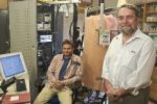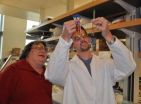(Press-News.org) Can a road-trip across eastern North America, ancient ice sheets, and DNA samples unlock the ancestral history of jack pine trees? Julie Godbout and colleagues from the Université Laval, Quebec, Canada, certainly hoped that driving across northeastern U.S. and Canada to collect samples from jack pine trees would shed some light on how glaciers may have impacted present-day pine genetics.
About 20,000 years ago, ice sheets covered most of the northern terrestrial surface of the continent of North America. For some boreal species this Last Glacial Maximum period may have profoundly influenced their present-day distribution and genetic diversity. Glaciers may have separated populations into isolated pockets and/or created barriers to dispersal and therefore gene flow.
In the November issue of the American Journal of Botany (http://www.amjbot.org/cgi/reprint/97/11/1903), Godbout and colleagues examined the genetic structure of jack pine (Pinus banksiana), one of the dominant tree species in the North American boreal forest, to see if they could determine its geographic history since the Last Glacial Maximum. In previous studies they had discovered that populations of jack pine from central and western Canada were genetically distinct from eastern populations. Moreover, the eastern populations were genetically quite diverse and heterogeneous, much more so than the central and western groups. Why was this?
"This study follows up a first rangewide phylogeographical work on jack pine that set us thinking that populations from the Maritimes region [New Brunswick, Nova Scotia, and Prince Edward Island] were genetically distinct from the rest," Godbout stated.
On their road trip across New England and the Maritimes provinces the authors completed their sampling of 1240 jack pine trees in 83 populations, collecting pine needles and young seedlings. Pine seeds generally are more restricted geographically in their dispersal than pollen, which can be dispersed for hundreds of kilometers by the wind, so the authors extracted both mitochondrial DNA (inherited only via seeds) and chloroplast DNA (passed down via both seeds and pollen) to help piece together the geographic structure of the species.
The authors found interesting differences between how the mitochondrial DNA (mtDNA) and the chloroplast DNA (cpDNA) were distributed geographically. Based on the mtDNA, the eastern populations were genetically distinct from the central and western Canada populations—supporting their earlier findings. Within the eastern populations one of the 15 distinct mitotypes (mitochondrial haplotypes) was almost exclusively found in the Maritimes region and there were some genetically diverse populations in New York, Vermont, and Maine. These data indicate that perhaps these populations descended from a unique ancient population that may have been isolated from others during the last maritime ice age.
The cpDNA structure was much more uniform across the entire region, although three of the 16 most abundant chlorotypes were found primarily in the same maritime region as the one distinct mitotype. The more uniform cpDNA data probably reflect the fact that pollen is much more widely dispersed than seeds—thus dispersal via pollen since the last ice age may obscure ancient population structures. Genomes dispersed only in the seeds (such as mtDNA) may have much lower levels of gene flow and thus may better reflect past genetic patterns compared to genome dispersed in pollen.
"We believe that this genetic structure is directly related to the species particular glacial history in a region supposedly affected by fluctuations of the Atlantic Ocean sea-level during glaciations," Godbout said. "Indeed, since a large amount of water was sequestered in the ice sheets, some emerged parts of the continental shelf suitable for the survival of jack pine possibly sheltered small glacial populations geographically isolated from populations located southward on the Atlantic plain."
This would point to a three-prong ancestry for jack pines—one from populations located on the southern edge of the glaciers in central and western parts of Canada west of the Appalachian Mountains, a second one in the east from an Atlantic coastal population, and a third in the Maritimes area potentially from an isolated population on the fringe of the ice cap.
"The aim of this work was to verify whether populations of jack pine, a typical tree of the North American boreal forests, presented a distinctive genetic signature in the Maritimes region, which proved to be true," Godbout concludes. Moreover, "If jack pine survived the ice age in a cryptic refugium along the Atlantic coast, other species may have also experienced a similar event."
"It may be interesting to compare our results with other phylogeographical works targeting the Atlantic and/or eastern boreal region species," Godbout notes. "This may allow the detection of genetic trends consolidating (or not) the hypothesis of a coastal refugium in the northern Atlantic region, as was previously done in the Pacific Northwest region. Unfortunately, at this time, few phylogeographical studies investigating this area are available."
And Godbout's take-home from the road trip? She jokes, "An alternative conclusion of this work would be that the entire state of Maine is really beautiful."
###
CITATION: Julie Godbout, Jean Beaulieu, and Jean Bousquet (2010). Phylogeographic structure of jack pine (Pinus banksiana; Pinaceae) supports the existence of a coastal glacial refugium in northeastern North America. American Journal of Botany 97(12): 1903-1912. DOI: 10.3732/ajb.1000148
The full article in the link mentioned is available for no charge for 30 days following the date of this summary at http://www.amjbot.org/cgi/reprint/97/11/1903. After this date, reporters may contact Richard Hund at ajb@botany.org for a copy of the article.
The Botanical Society of America (www.botany.org) is a non-profit membership society with a mission to promote botany, the field of basic science dealing with the study and inquiry into the form, function, development, diversity, reproduction, evolution, and uses of plants and their interactions within the biosphere. It has published the American Journal of Botany (www.amjbot.org) for nearly 100 years. In 2009, the Special Libraries Association named the American Journal of Botany one of the Top 10 Most Influential Journals of the Century in the field of Biology and Medicine.
For further information, please contact the AJB staff at ajb@botany.org.
Blast from the past: Jack pine genetics support a coastal glacial refugium
DNA evidence supports a coastal northeastern Atlantic glacial refugium for a boreal tree species
2010-11-30
ELSE PRESS RELEASES FROM THIS DATE:
A 'USB' for medical diagnosis?
2010-11-30
Biomedical engineers at UC Davis have developed a plug-in interface for the microfluidic chips that will form the basis of the next generation of compact medical devices. They hope that the "fit to flow" interface will become as ubiquitous as the USB interface for computer peripherals.
UC Davis filed a provisional patent on the invention Nov. 1. A paper describing the devices was published online Nov. 25 by the journal Lab on a Chip.
"We think there is a huge need for an interface to bridge microfluidics to electronic devices," said Tingrui Pan, assistant professor ...
Tempest in a teapot: International team of scientists describes swirling natural phenomena
2010-11-30
(Santa Barbara, Calif.) –– Scientists can use cylinders as small as teapots to study the mechanisms involved in powerful hurricanes and other swirling natural phenomena.
The earth's atmosphere and its molten outer core have one thing in common: Both contain powerful, swirling vortices. While in the atmosphere these vortices include cyclones and hurricanes, in the outer core they are essential for the formation of the earth's magnetic field. These phenomena in earth's interior and its atmosphere are both governed by the same natural mechanisms, according to experimental ...
Hormone oxytocin bolsters childhood memories of mom's affections
2010-11-30
Researchers have found that the naturally-occurring hormone and neurotransmitter oxytocin intensifies men's memories of their mother's affections during childhood. The study was published today in Proceedings of the National Academy of Sciences.
Researchers at the Seaver Autism Center for Research and Treatment at Mount Sinai School of Medicine wanted to determine whether oxytocin, a hormone and neurotransmitter that is known to regulate attachment and social memory in animals, is also involved in human attachment memories. They conducted a randomized, double-blind, ...
Caffeinated alcoholic beverages -- a growing public health problem
2010-11-30
San Diego, CA, November 30, 2010 – In the wake of multiple state bans on caffeinated alcoholic beverages (CABs) and an FDA warning to four companies to remove their products from the marketplace, an article published online today in the American Journal of Preventive Medicine delineates the scope of the public health problem and suggests areas of research that might help address it.
"Although several manufacturers of caffeinated beer have withdrawn their products from the market, there is no sign that young people have decreased the practice of combining alcohol and energy ...
Neuroscience of instinct: How animals overcome fear to obtain food
2010-11-30
When crossing a street, we look to the left and right for cars and stay put on the sidewalk if we see a car close enough and traveling fast enough to hit us before we're able to reach the other side. It's an almost automatic decision, as though we instinctively know how to keep ourselves safe.
Now neuroscientists have found that other animals are capable of making similar instinctive safety decisions. In a study published online the week of Nov. 29 in the Proceedings of the National Academy of Sciences, University of Washington researcher Jeansok Kim demonstrates that ...
Motivation to end racism relies on 'yes we can' approach
2010-11-30
If you're trying to end racism, it's not enough to get people to understand that racism is still a problem. You also have to make them feel like they can do something about it, according to a new study published in Psychological Science, a journal of the Association for Psychological Science.
Tracie L. Stewart of Georgia State University was inspired to conduct the study by work she's done on evaluating a popular diversity training program. She found that the program reduced many white participants' bias in the short term, which was good. "But some white participants ...
Abnormal blood vessel function found in women with broken heart syndrome
2010-11-30
ROCHESTER, Minn. - A team of Mayo Clinic researchers has found that patients with broken heart syndrome, also known as apical ballooning syndrome (ABS), have blood vessels that don't react normally to stress. These results offer clues to the cause of this rare syndrome and may help with efforts to identify patients who are more vulnerable to mental stress so that appropriate therapies can be developed. The study is published online in the Journal of the American College of Cardiology.
Apical ballooning syndrome affects mainly postmenopausal women, and a few men. The symptoms ...
Study: Avoidance, poor coping challenge prisoners returning to society
2010-11-30
How do individuals often cope with reentry from prison to society?
Too frequently with avoidance, says Lindsay Phillips, assistant professor of psychology at Albright College in Reading, Pa. and author of the forthcoming paper, "Prison to Society: A Mixed Methods Analysis of Coping with Reentry," to be published by the International Journal of Offender Therapy and Comparative Criminology.
"There is a defined process experienced by participants, which is initial optimism about release, followed by craving substances, facing practical barriers, or feeling overwhelmed," ...
How authentic is your pomegranate juice?
2010-11-30
RIVERSIDE, Calif. – You pick up a bottle of pomegranate juice at the store because you've learned that, although it costs more than most juices, it is replete with antioxidants that bring health benefits. But wait: Is the juice you've purchased really pomegranate juice? Or is the product label you have carefully read promising more than it delivers?
A chemist at the University of California, Riverside is determined to find out. Cynthia Larive, a professor of chemistry, is playing detective by applying chemical tests to juice products sold as pomegranate juice or pomegranate ...
Evolutionary psychology: Why daughters don't call their dads
2010-11-30
CORAL GABLES, FL (December 7, 2010)— Previous research has shown that when women are in their most fertile phase they become more attracted to certain qualities such as manly faces, masculine voices and competitive abilities. A new study by University of Miami (UM) Psychologist Debra Lieberman and her collaborators offers new insight into female sexuality by showing that women also avoid certain traits when they are fertile.
The new study shows that women avoid their fathers during periods of peak fertility. The findings are included in a study entitled "Kin Affiliation ...
LAST 30 PRESS RELEASES:
Making lighter work of calculating fluid and heat flow
Normalizing blood sugar can halve heart attack risk
Lowering blood sugar cuts heart attack risk in people with prediabetes
Study links genetic variants to risk of blinding eye disease in premature infants
Non-opioid ‘pain sponge’ therapy halts cartilage degeneration and relieves chronic pain
AI can pick up cultural values by mimicking how kids learn
China’s ecological redlines offer fast track to 30 x 30 global conservation goal
Invisible indoor threats: emerging household contaminants and their growing risks to human health
Adding antibody treatment to chemo boosts outcomes for children with rare cancer
Germline pathogenic variants among women without a history of breast cancer
Tanning beds triple melanoma risk, potentially causing broad DNA damage
Unique bond identified as key to viral infection speed
Indoor tanning makes youthful skin much older on a genetic level
Mouse model sheds new light on the causes and potential solutions to human GI problems linked to muscular dystrophy
The Journal of Nuclear Medicine ahead-of-print tip sheet: December 12, 2025
Smarter tools for peering into the microscopic world
Applications open for funding to conduct research in the Kinsey Institute archives
Global measure underestimates the severity of food insecurity
Child survivors of critical illness are missing out on timely follow up care
Risk-based vs annual breast cancer screening / the WISDOM randomized clinical trial
University of Toronto launches Electric Vehicle Innovation Ontario to accelerate advanced EV technologies and build Canada’s innovation advantage
Early relapse predicts poor outcomes in aggressive blood cancer
American College of Lifestyle Medicine applauds two CMS models aligned with lifestyle medicine practice and reimbursement
Clinical trial finds cannabis use not a barrier to quitting nicotine vaping
Supplemental nutrition assistance program policies and food insecurity
Switching immune cells to “night mode” could limit damage after a heart attack, study suggests
URI-based Global RIghts Project report spotlights continued troubling trends in worldwide inhumane treatment
Neutrophils are less aggressive at night, explaining why nighttime heart attacks cause less damage than daytime events
Menopausal hormone therapy may not pose breast cancer risk for women with BRCA mutations
Mobile health tool may improve quality of life for adolescent and young adult breast cancer survivors
[Press-News.org] Blast from the past: Jack pine genetics support a coastal glacial refugiumDNA evidence supports a coastal northeastern Atlantic glacial refugium for a boreal tree species



